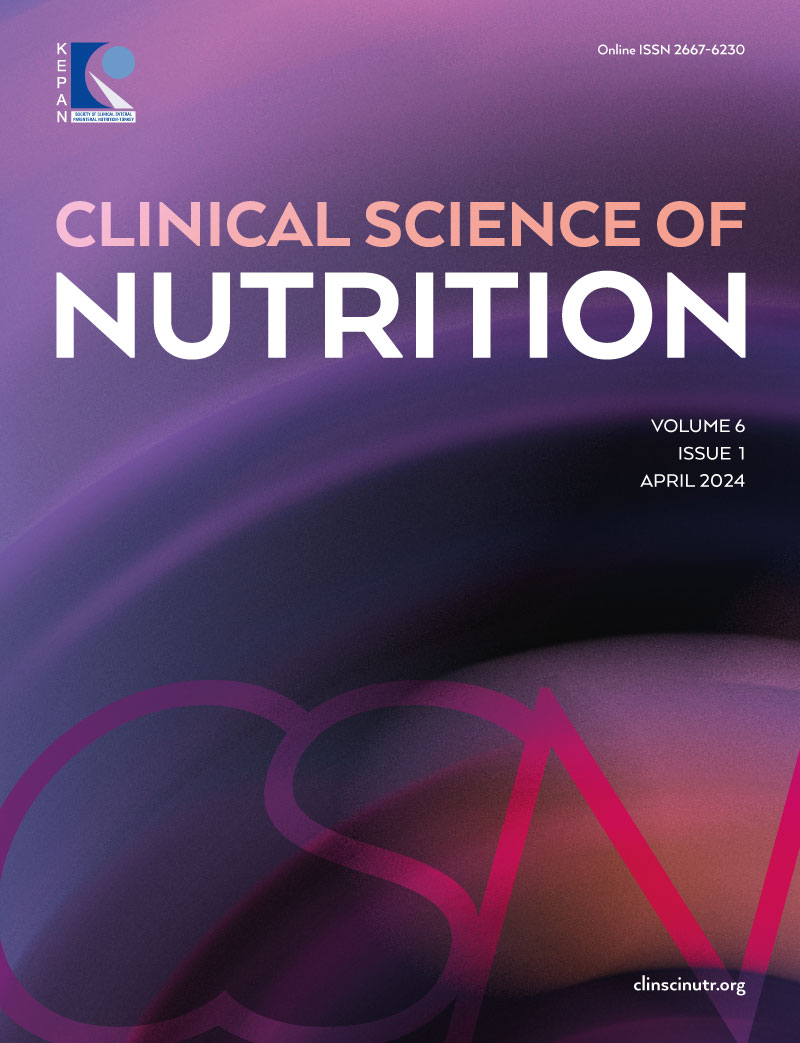Abstract
Objective: Nutritional support products should preferably be administered orally whenever possible, with rare exceptions, one of which is gastrointestinal bleeding. In our study, we examined the effects of parenteral nutrition support, which we have recently introduced in the treatment of patients with gastrointestinal bleeding, on the hospitalization duration and mortality-morbidity of these patients.
Methods: We analyzed the patients admitted to the Internal Medicine Service with non-variceal upper gastrointestinal bleeding in our study. Patients were retrospectively analyzed in two groups, based on the years in which total parenteral nutrition (TPN) was initiated (2016-2017) and not initiated (2012-2013). Hospitalization durations and discharge methods were compared between the two groups.
Results: Our study included a total of 369 cases after screening and application of our exclusion criteria. 35.5% of these cases received TPN, while 64.5% did not. When evaluated based on the TPN administration status after stabilizing the Rockall score of the patients, as well as considering the need for erythrocyte suspension (ES), fresh frozen plasma (FFP) replacement, and length of hospital stay, the length of hospital stay was significantly longer in those receiving TPN compared to those who did not.
Conclusion: Although TPN may be the preferred choice in patients with upper gastrointestinal bleeding for whom oral nutrition is not suitable, our study suggests that this preference not only does not lead to a reduction in the number of blood and blood product replacements but also prolongs the hospital stay. While it is believed that complications of nutritional support with TPN may contribute to this result, our retrospective study did not provide data on this. Comprehensive prospective studies are needed on this issue.
Keywords: Parenteral nutrition, non-variceal upper gastrointestinal bleeding, mortality
References
- Kamboj AK, Hoversten P, Leggett CL. Upper Gastrointestinal Bleeding: Etiologies and Management. Mayo Clin Proc. 2019;94:697-703. https://doi.org/10.1016/j.mayocp.2019.01.022
- Peery AF, Crockett SD, Murphy CC, et al. Burden and Cost of Gastrointestinal, Liver, and Pancreatic Diseases in the United States: Update 2018. Gastroenterology. 2019;156:254-272.e11. https://doi.org/10.1053/j.gastro.2018.08.063
- Rockall TA, Logan RF, Devlin HB, Northfield TC. Risk assessment after acute upper gastrointestinal haemorrhage. Gut. 1996;38:316-321. https://doi.org/10.1136/gut.38.3.316
- Blatchford O, Murray WR, Blatchford M. A risk score to predict need for treatment for upper-gastrointestinal haemorrhage. Lancet. 2000;356:1318-1321. https://doi.org/10.1016/S0140-6736(00)02816-6
- Stevenson J, Bowling K, Littlewood J, Stewart D. Validating the Glasgow Blatchford Upper GI bleeding scoring system. Gut. 2013;62:A21-A22. https://doi.org/10.1136/gutjnl-2013-305143.49
- Stanley AJ, Laine L, Dalton HR, et al. Comparison of risk scoring systems for patients presenting with upper gastrointestinal bleeding: international multicentre prospective study. BMJ. 2017;356:i6432. https://doi.org/10.1136/bmj.i6432
- Singer P, Berger MM, Van den Berghe G, et al. ESPEN Guidelines on Parenteral Nutrition: intensive care. Clin Nutr. 2009;28:387-400. https://doi.org/10.1016/j.clnu.2009.04.024
- Berger MM, Pichard C. When is parenteral nutrition indicated? J Intensive Med. 2022;2:22-28. https://doi.org/10.1016/j.jointm.2021.11.006
- Barkun AN, Almadi M, Kuipers EJ, et al. Management of Nonvariceal Upper Gastrointestinal Bleeding: Guideline Recommendations from the International Consensus Group. Ann Intern Med. 2019;171:805-822. https://doi.org/10.7326/M19-1795
- Rassameehiran S, Nugent K, Rakvit A. When Should a Patient with a Nonvariceal Upper Gastrointestinal Bleed Be Fed? South Med J. 2015;108:419-424. https://doi.org/10.14423/SMJ.0000000000000314
- Zhang H, Wang Y, Sun S, et al. Early enteral nutrition versus delayed enteral nutrition in patients with gastrointestinal bleeding: A PRISMA-compliant meta-analysis. Medicine (Baltimore). 2019;98:e14864. https://doi.org/10.1097/MD.0000000000014864
- Berger MM. The 2013 Arvid Wretlind lecture: evolving concepts in parenteral nutrition. Clin Nutr. 2014;33:563-570. https://doi.org/10.1016/j.clnu.2014.03.005
- Achamrah N, Oshima T, Genton L. Innovations in energy expenditure assessment. Curr Opin Clin Nutr Metab Care. 2018;21:321-328. https://doi.org/10.1097/MCO.0000000000000489
- Nicolo M, Heyland DK, Chittams J, Sammarco T, Compher C. Clinical outcome related to protein delivery in the critically ill population: A multicenter, multinational observation study. JPEN J Parenter Enteral Nutr. 2016;40:45-51. https://doi.org/10.1177/0148607115583675
- Zusman O, Theilla M, Cohen J, Kagan I, Bendavid I, Singer P. Resting energy expenditure, calorie and protein consumption in critically ill patients: a retrospective cohort study. Crit Care. 2016;20:367. https://doi.org/10.1186/s13054-016-1538-4
- Berlana D. Parenteral Nutrition Overview. Nutrients. 2022;14:4480. https://doi.org/10.3390/nu14214480
Copyright and license
Copyright © 2024 The author(s). This is an open-access article under the terms of the Creative Commons Attribution License (CC BY) which permits unrestricted use, distribution, and reproduction in any medium or format, provided the original work is properly cited.










